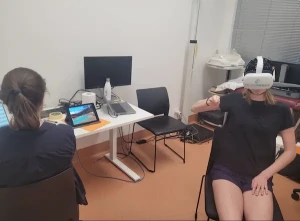Will your competent? doctor bring this into the hospital practice?
Do you prefer your doctor and hospital incompetence NOT KNOWING? OR NOT DOING?
Virtual Reality in Stroke Rehabilitation
Dr Merel Hoskens, a lecturer in health, sport and human performance at the University of Waikato and Dr Jodie Marquez, Director of Research Ethics and Integrity at the University of Newcastle, participated in the joint seed funding initiative offered by both universities to compare VR therapy to real-world therapy. Neuromersiv, a private company specialising in VR for neuro-rehabilitation provided the VR devices and the University of Newcastle supplied the brain imaging tools for this project.

Dr Merel Hoskens and study participants performing a wire aze task in the VR environment which they also perform as a real life task.
VR vs Real-World Therapy
Project findings revealed that while VR therapy offers a 'gamified' experience that is more engaging, it might not trigger the same motor functions essential for stroke recovery.
“When you perform tasks in the real world, the areas of the brain that control movement are more active compared to virtual reality,” says Marquez.
Dr Marquez, who specializes in stroke recovery, adds that VR may struggle to replicate crucial activities for brain recovery. "For stroke recovery, we need to drive the brain as much as possible with high repetition, high intensity, task-specific activity—something VR might not be able to replicate," she explains.
The Challenge of Motor-Sensory Feedback
One of the key challenges with VR, according to Dr. Marquez, is the absence of sensory feedback, which is crucial for motor learning and recovery. "When we pick something up, we already have a sense of its size, shape, and weight, and that helps us create a motor plan," she explains.
"In the real world, our brains rely on this sensory information to adjust our movements and ensure proper coordination."
In contrast, virtual objects do not offer the same tactile feedback. “In the virtual world, objects aren’t real, so when I try to pick up a virtual object, it has no weight, and I’m not receiving any sensory feedback about whether my grip is firm or if my hand is fully engaged with the object,” Marquez says. "This lack of feedback makes it harder to engage the brain in the same way that real-world objects do."
VR as a Complementary Tool in Rehabilitation
Despite these challenges, Hoskens and Marquez agree that VR has a place in rehabilitation, especially for patients who are in the long-term stages of recovery. VR could help keep patients engaged in the rehabilitation process, particularly when traditional therapy tasks become repetitive and monotonous. "If someone is failing at real-world tasks and is feeling discouraged, VR could provide a way to practice without that fear of failure," Marquez suggests. As patients experience improvement through VR, they could transition back to real-world tasks with greater confidence.
Hoskens points out, however, that VR therapy still misses out on the crucial therapist feedback(I never considered therapist feedback necessary since recovery would be enough feedback. Give us EXACT REHAB PROTOCOLS and we'll recover on our own, because we will see the results. Therapist feedback is just one measure of trying to trick patients into being motivated. Give us 100% recovery protocols and that is all the motivation needed! Do you understand?) that is essential for motor recovery. “In addition to missing out on sensory feedback using VR, you miss the feedback from a therapist who can correct your movements or help you progress in the right way, which is important for how we train motor skills after a stroke,” she says.
The Need for Further Research
While the pilot study provides valuable insights, the researchers caution against over-generalizing the results. "This was a pilot study which involved a small sample of healthy individuals, so we can’t overstate the findings just yet," Marquez says.
Hoskens and Marquez are planning to continue their research with stroke patients to further explore the potential of VR as a therapeutic tool. They hope that their findings will help secure funding for larger-scale studies to better understand the role of VR in rehabilitation and to improve VR devices and make them more suitable for neuro-rehabilitation.
The Future of VR in Stroke Recovery
Ultimately, Hoskens and Marquez believe that VR could become a valuable tool in rehabilitation, but it must be used alongside traditional therapies to ensure the best outcomes for stroke patients. The key to VR's success in rehabilitation will be understanding when and how it can be used to maximize recovery, particularly for stroke survivors who face long-term challenges.
Republished with permission from The University of Newcastle Australia, strategic partner of the University of Waikato. View the original article on the University of Newcastle website. Learn more about the University of Waikato and University of Newcastle partnership seed fund.
No comments:
Post a Comment